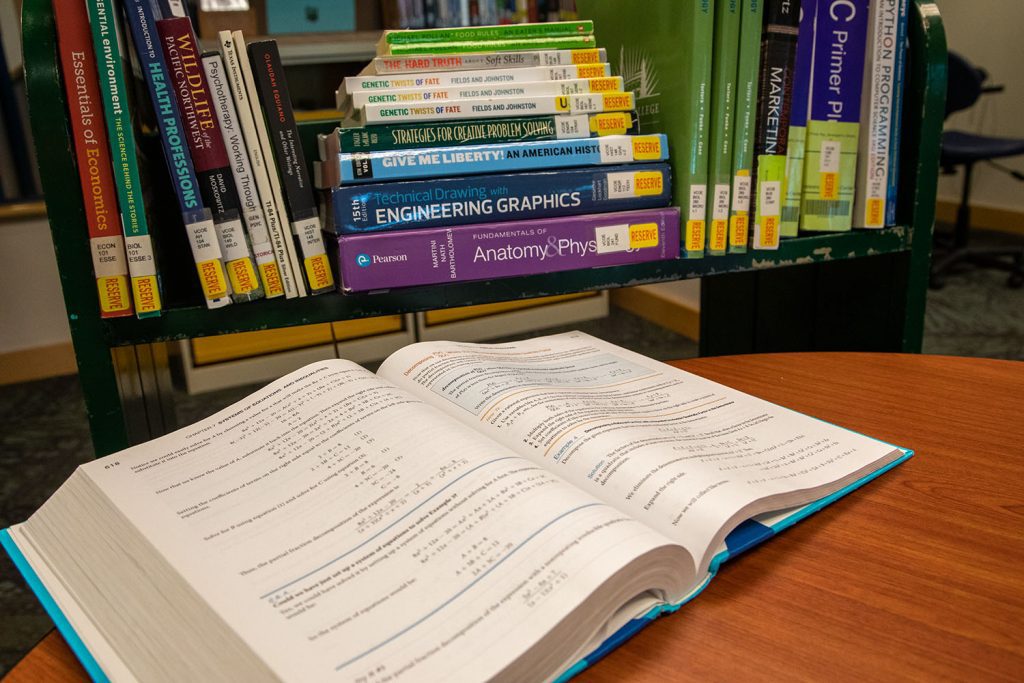Student by student: thinking outside the scholarship
6 minute read
Facing a national decline in college enrollment, donors are finding creative ways to help students get back, and stay, in the classroom

Clark College Foundation donors are part of the solution, stepping up with creative ways—big and small—to help students get back in the classroom. Illustration by Bryce Van Patten ’18, ’20. Student photo by freepikcompany
Across the nation, colleges faced an unprecedented enrollment and retention crisis even before the COVID-19 pandemic. In the 2008-2009 academic year, 471,145 students—the highest number ever recorded—were enrolled in Washington’s 34 community and technical colleges. By the 2019-2020 school year, that number had dropped more than 28% to 337,618.
The pandemic caused enrollment to plummet further, along with retention numbers. Students got laid off from their jobs and couldn’t afford to continue with college, not to mention their children were home from school and day care. In Washington, enrollment at two-year colleges in the 2021-2022 school year dropped to 229,182—less than half of what it was 13 years earlier.
These trends are grim but make no mistake, Clark College Foundation is supporting the college to get students back in the classroom. The foundation is connecting donors with creative ways to fulfill their interests and legacies. From a transformative gift in support of a growing department to paying for students’ exam and licensing fees to building a textbook lending library, donors are finding ways, big and small, to help students earn their degrees. That creativity is on top of the more than $1 million in scholarships awarded to Clark students each year by the foundation.
“Donors are looking to provide direct support to students that go beyond traditional scholarships,” said Vivian Manning, Clark College Foundation’s director of development and gift planning.
Manning said one donor who funds nursing students’ scholarships, for example, also pays graduates’ exam and licensing fees, to help make sure students transition from Clark to the workplace without racking up cumbersome bills. And Clark’s Veterans Center of Excellence is using donated funds to make textbooks and e-books available to students for free.
Laura McDowell, communications director for Washington State Board of Community and Technical Colleges, said this kind of direct support can make all the difference for students.
“That one decision to make books available and save a student $400 could allow that student to stay in college,” she said. “And that will have a lifetime of benefits for that student and for that student’s community. The benefits ripple out in ways that pay back many more times over.”
Program funds are a game changer
Other donors contribute to program funds, which provide unrestricted money for a department’s faculty to spend at their discretion to aid students. In the geology department, for example, program funds help students cover the costs of attending conferences and workshops. Program money has also been used to pay students’ membership fees for professional organizations.
In Clark’s Veterans Center of Excellence, a program fund covers emergency grants for students who need one-time help covering utilities, rent, food or other bills. When a veteran decides to enroll, it can take a month or two to receive their GI benefits. If a tuition bill is due before then, emergency funds could be the difference between enrolling in college or not.
Community college students face significant financial challenges right now.
“Community colleges are serving more students who are living on the edge financially,” said McDowell. “They may have to make very difficult choices about whether they can pay a bill or go to school.”
A report released in February 2020 found that six out of 10 community college students in Washington experienced hunger or housing insecurity in the past year even though most of them were working. That was before food and housing costs skyrocketed during the pandemic.

Donors have contributed money to cover the cost of buying a collection of used textbooks for veterans. Student-veterans access the books in Clark’s Cannell Library. Photo by Jenny Shadley
Donna Larson, associate director of the Veterans Center of Excellence at Clark, said one student was out of town the first week of spring term, dealing with a family emergency. The student called, worried because she hadn’t yet purchased her textbooks. Larson has a fund made possible by donor contributions to cover textbooks. She used this money to buy the student’s books, which cost $585.
“That’s a lot of money for our students,” Larson said. “If they’re buying textbooks one month instead of paying their rent, it’s really hard to come out from under that.”
Students usually donate their textbooks back. There are about 200 veterans enrolled at Clark College and about 50 of them use the textbook lending library or get help from the book program fund, according to Larson.
Cybersecurity in demand
In May 2022, philanthropist and restaurant franchise owner Tom Cook announced a major gift—$2 million to support Clark’s new cybersecurity program. The program allows students who’ve already earned an associate degree or bachelor’s degree to earn a bachelor of applied science in cybersecurity in two years. Trained cybersecurity specialists are in high demand, with salaries starting in the six figures.
The department is building a cyber range—a closed-off network where students can practice defending against hacks, malware and viruses. Students can team up and battle each other, with one team trying to hack into a system and the other trying to prevent it. Unlike an actual network, the computers in a cyber range are easily reset, so mistakes don’t require costly, arduous repairs.
A recent grant, along with a portion of Cook’s generous gift, will support the construction of this new range, the first community college owned and hosted cyber range in the Pacific Northwest and one of the first at any community college in the U.S.
“This puts Clark on the map,” said Dwight Hughes, professor of computer science and director of Clark’s cybersecurity program.
Currently, students pay about $180 per course to subscribe to software that mimics some of what a cyber range can do. When the cyber range is built, Hughes said, students will get a richer educational experience for less money. Their course costs will drop to about $50 for a textbook. Additionally, private corporations will be able to rent the range to train their employees, further offsetting costs.
We’re hiring
The cybersecurity program has a six-month waitlist for students. Clark College administration approved another tenure track professor and when that position is hired, the college will admit an additional 24-student cohort, which Hughes said could be filled immediately, making a small but welcome dent in Clark’s enrollment issue.
But Hughes said hiring a high-quality faculty member is easier said than done, especially in a field where a seasoned expert could earn $300,000 per year in the private sector. A recent posting for the new tenure track position yielded just three applications.
“We don’t have a solution for this right now,” Hughes said. Even if he had funding for that kind of competitive wage, college and union policies would prevent it.
While the search for full-time cybersecurity faculty is underway, there are well-qualified professionals who want to teach part time, he said. Joel B. Munson, outgoing chief advancement officer of Clark College Foundation, said Cook’s gift to support the department is, ultimately, an opportunity for students that will result in higher enrollment and retention. Well-funded programs—which are often supported by philanthropy, Munson added—are “like magnets to students.”
“It’s that extra layer of funding that matters when it comes to recruitment and retention of students,” Munson said. “Students want to be in quality programs with quality professors and technology. That’s why Tom Cook’s gift is such a big deal. This transformational gift will allow Clark College to do things it could only dream about before, and that will have a huge impact on an already popular and quality program.”
Supporting the underserved
High quality faculty are repeatedly linked to retaining students, especially students from historically underserved communities.
Clark College Foundation’s work in support of the college is one part of a broader response to ongoing enrollment and retention challenges. In 2021, a committee of Clark College administrators began working on a three-year strategic enrollment management plan to increase enrollment by 5% by 2024. Dr. Michele Cruse, vice president of student affairs at Clark, serves on the committee. Other goals include increasing student retention and halving the equity gap between historically underserved populations.
“The benefits of increasing enrollment and retention include lifting families out of poverty, increasing post-secondary credentials in Washington and closing the equity gaps for first-generation students, students with disabilities and systemically excluded students,” Cruse said.
Experts say equity is a key to increasing college enrollment. About half of all 25- to 44-year-olds in Washington have a college degree. But only 30% of Black, 20% of Hispanic and 20% of Native American Washingtonians in that age group have a college degree. Historically underserved students are also more likely to leave college without completing their education.
“Clark College is committed to building an environment where all students feel welcome, accepted and valued,” ~ Dr. Michele Cruse, vice president of student affairs
The state is working to reverse declining enrollment and retention. McDowell, a spokesperson for the agency governing two-year colleges in Washington, said the legislature recently funded community-based organizations to help potential students fill out financial aid applications. The forms are complicated and can be a barrier to enrollment. By hiring organizations that are already a touchpoint for underserved communities, the state could recruit new students.
Bright spots
Summer Kenesson, interim director of policy research for Washington State Board for Community and Technical Colleges, said there are plenty of reasons why it’s important to reverse declining enrollment.
A person’s lifetime earnings increase with credentials, so when people attend college, they raise their earning potential. And trained people bring valuable skills and knowledge to their community. This year’s automotive students will be the area’s car mechanics in a year or two.
If the country doesn’t reverse its declining college enrollment, “it’s very concerning what the long-term effects will be, in terms of lower credentials, lower earnings and … what communities will do without these skills,” Kenesson said.
She is seeing some bright spots. Apprenticeship enrollment is increasing as the workforce opens back up. And students over the age of 40 are attending community colleges at higher rates than in recent years.
“These could be adults in careers who were heavily impacted by the pandemic,” she said, “and maybe they don’t want that insecurity, so they’re seeking to retrain.”
In general, community college enrollment rises during a recession and falls when the job market is strong—which explains why Washington’s community and technical college enrollment peaked during the 2008-2009 academic year, mid-recession. In a healthy, growing economy, workers are less inclined to go to college and change careers.
Potential students could see companies eager to hire as a sign of encouragement: if they go back to school and earn a degree or credential, they will be able to snag a higher paying job. And that means more stability over their lifetime.
In times like these, one donor’s textbook money could be a student’s determining factor.
Written by Lily Raff McCaulou, whose writing has appeared in The New York Times, The Atlantic, The Guardian and Rolling Stone. Visit her online at www.lilyrm.com.



